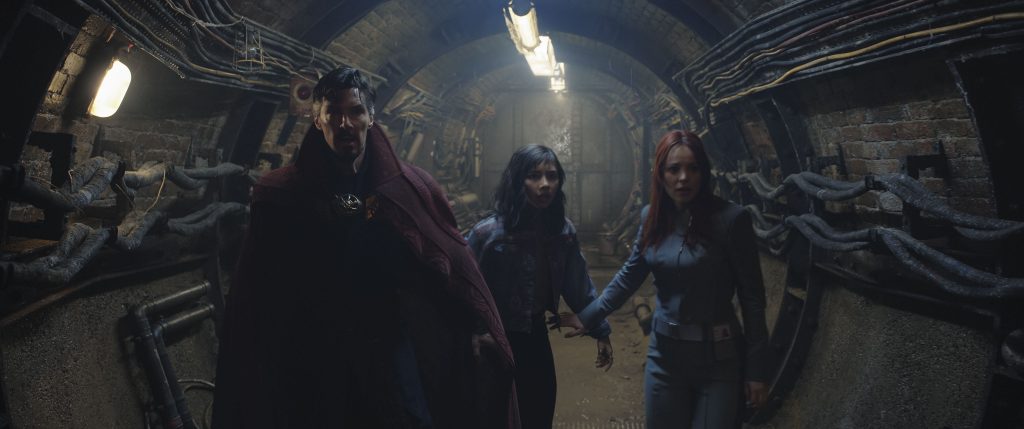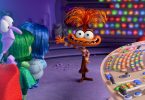The Marvel Cinematic Universe is now 24 years old and 28 films deep into the superhero genre and there’s no doubt that its films have fallen into a rhythm with their format. Don’t get me wrong; they’re still as enjoyable as ever, but their style and presentation often blend and bleed into one another. There are notable exceptions like James Gunn’s Guardians of the Galaxy, Taika Waititi’s Thor: Ragnarok, and Ryan Coogler’s Black Panther where you can feel the full impact of the director’s style within the film but they are often the exception and not the rule when it comes to the MCU. And now thanks to Sam Raimi, we have Doctor Strange in the Multiverse of Madness to add to the list. While a little overstuffed, the film lives up to its namesake and embraces its strangeness, falling deep into madness with Raimi’s love of horror to deliver something truly different from all the other Marvel Studios fanfare.
Doctor Strange (Benedict Cumberbatch) has been plagued lately by a nightmare in which he and a young girl named America Chavez (Xochitl Gomez) are on the run from a monster who wants to steal America’s ability that allows her to travel through the multiverse. But when Strange encounters her on the streets of New York while she is running away from a different monster this time around, he discovers that it wasn’t just a dream but a look into an alternate version of himself. Offering to help America get rid of the demons chasing her, Strange goes to Wanda (Elizabeth Olsen) to get some insight into the witchcraft magic that is after them. Together they will traverse the multiverse and discover the hidden truths of not just this world but all other worlds in an effort to save America and her powers.
There is a lot going on with Doctor Strange in the Multiverse of Madness, and with a running time that’s barely over two hours, the film wastes no time jumping into the action. Spider-Man: No Way Home gave audiences a small taste with its multiverse opening portals, but Multiverse of Madness dives in head first. There are multiple Stranges, multiple Wandas, and plenty of other secrets and cameos spread across the various universes waiting to be discovered that I won’t spoil. Suffice to say, it’s a wild and fun ride that doesn’t shy away from getting weird.

And when it gets weird is when the film and director Sam Raimi is at their best. Raimi’s use of the camera to make audiences uneasy is legendary. The camera is rarely still, swooping in for these dramatic wide shots that dance across the screen. It twists and turns, landing on off-center angles that help in making you feel like something isn’t quite right. Multiverse of Madness is probably as close to a horror film as Marvel Studios is going to get. If you’ve seen any of the Evil Dead franchise or Drag Me to Hell, you’ll know exactly what Raimi is capable of. Like Gunn, Coogler, and Waititi, Raimi brings his unique style to the MCU. At times the film feels like a slasher, with the monster chasing Doctor Strange and America being constantly at their heels and nothing they throw at it is able to stop it. The trailers have shown zombies, giant octopuses, and all sorts of oddities, and that’s just the beginning of what Raimi has fun with. There is also a sequence in the middle involving the Illuminati that is just bonkers. It does feel a little out of place compared to the rest of the film, but prepare to have your mind blown. The film is at its best when Raimi gets creative and wild with it, as evident by a stunning magic battle involving Strange and some perfectly played music. You’ll definitely know it when you see/hear it. No other film in the MCU feels more like a director’s vision than Doctor Strange in the Multiverse of Madness.
That being said, the film does feel like a bit too much at times as it moves from one set piece to the next without being able to catch its breath. America Chavez is fun, and Xochitl Gomez gives an entertaining performance, but there’s little worth mentioning about the character. She’s the driving force behind the film, but she’s more of a macguffin than an actual person. She’s painted with such broad strokes that it’s difficult to get to know her other than the fact that everyone wants her power. While it’s nice to have a Marvel film that hovers right around the two hour mark, I honestly could have had it be a little longer if it went more in depth just a little.
Phase Four of the Marvel Cinematic Universe has gotten off to a rocky start, but Doctor Strange in the Multiverse of Madness proves that there is still plenty of life left in the multiverse. The horror elements that Sam Raimi brings are top notch, even within the confines of Marvel Studios’ storytelling. There’s a lot to take in and while not everything works all the time, it’s refreshing to see a superhero film that steps outside of the box every once in a while. Hopefully Marvel Studios will give more directors more opportunities to be creative because that’s when the true magic happens.
-
Doctor Strange in the Multiverse of Madness
Summary
The Marvel Cinematic Universe is now 24 years old and 28 films deep into the superhero genre and there’s no doubt that its films have fallen into a rhythm with their format. Don’t get me wrong; they’re still as enjoyable as ever, but their style and presentation often blend and bleed into one another. There are notable exceptions like James Gunn’s Guardians of the Galaxy, Taika Waititi’s Thor: Ragnarok, and Ryan Coogler’s Black Panther where you can feel the full impact of the director’s style within the film but they are often the exception and not the rule when it comes to the MCU. And now thanks to Sam Raimi, we have Doctor Strange in the Multiverse of Madness to add to the list. While a little overstuffed, the film lives up to its namesake and embraces its strangeness, falling deep into madness with Raimi’s love of horror to deliver something truly different from all the other Marvel Studios fanfare.







